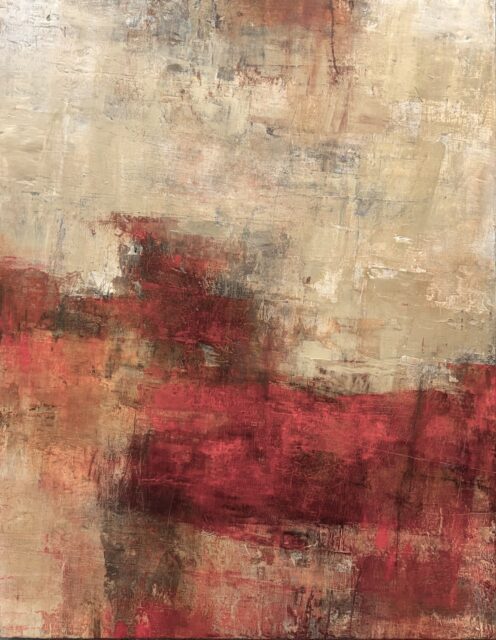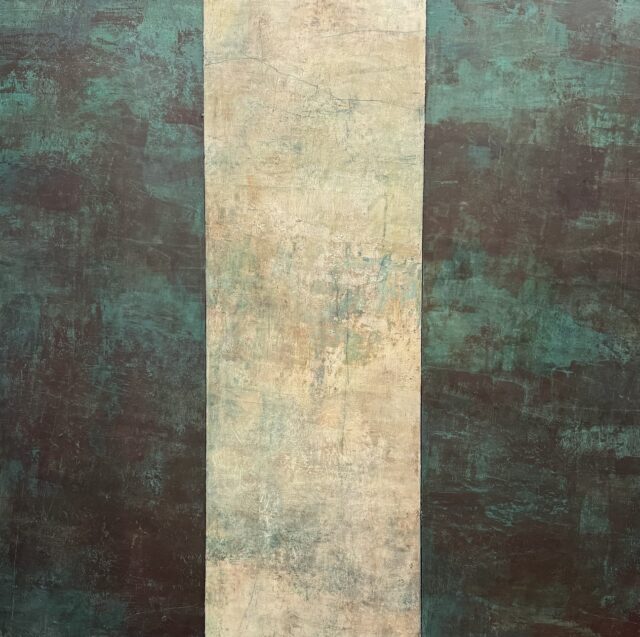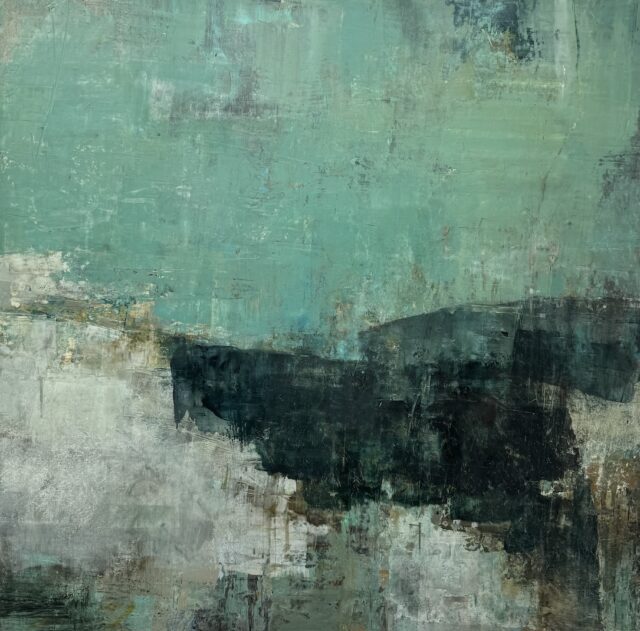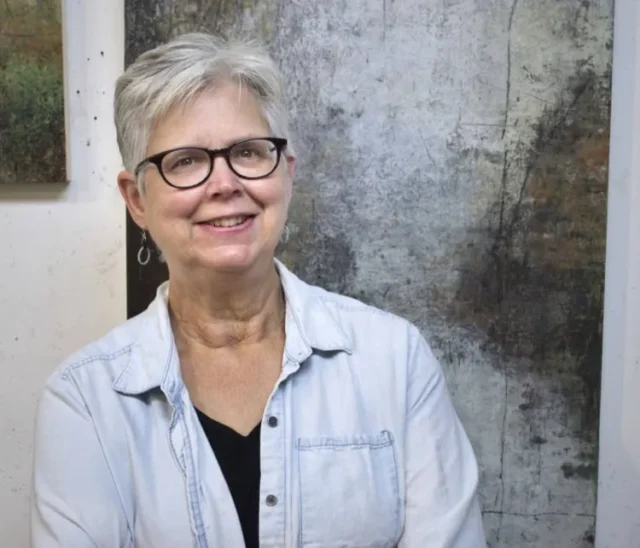Rebecca Crowell is often compared to mystical, magical Agnes Martin,. The latter was interested in the transcendent potential of painting and made extraordinary, visionary, minimalist, Abstract Expressionist images for over three decades until her death in 2004. Both women painted soulscapes, rather than squeaky clean landscapes that clearly and directly pay tribute to Mother Nature in all her glory. References to land and sky, mountains and water are there, but obscured in the interest of reliving the natural world from the inside, therefore filling a blank surface with what they felt, rather than saw.
A show of recent paintings by Abstract Expressionist 2.0, Rebecca Crowell, is on display through July at the Slate Gray Gallery. The exhibition, July 2 –July 28, follows on the heels of the artist’s sold-out advance Cold wax workshop titled “Lines and Marks as Abstract Language,” hosted by Telluride’s Ah Haa School for the Arts.
Crowell’s paintings can be summed simply as outward expressions of inner emotions – in response to her muse: Mother Nature. Same was true of that loose confederacy of artists who wore different hats, but traveled in a brat pack under the banner of Abstract Expressionism. That far-ranging aesthetic dominated the second decade of the 20th century, when the center of gravity of the art world shifted from Paris to New York (after World War II) and abstraction became the “ism” du jour and Holy Grail of modern art.
But again, that did not mean no clear subject. Just one that took second place to the emotional impact places and things had on a confederacy of artists.
AbEx can be parsed into two broad categories. “Action Painters” attacked their canvases with expressive brush strokes. That group included Jackson Pollack and Willem de Kooning. While The Mystics, Mark Rothko, Barnett Newman, Clyfford Still and Martin are examples, were deeply interested in religion and myth and created simple compositions featuring large swaths of color intended to produce a contemplative or meditational response in the viewer.
And Crowell?
“My paintings are always influenced by my surroundings, especially wild, natural places. The ancient, rugged landscapes of northern New Mexico where I live, and other remote places like the west coast of Ireland where I go each year form the basis of my abstract visual language. Their dramatic vistas are moving, but I’m also drawn to the more subtle aspects—the complex colors and textures, the shapes of rocks and landforms, and the luminous atmosphere I experience there.
“Those places feel like home to my soul, and evoke memories, emotions, a sense of connection, and reflections about time, aging, and resilience. Combined with elements of pure abstraction, they lead to imagery that is inner landscape, rather than literal depiction. I want to express what it means to me to be in such places, moved by their beauty and wildness. These rugged landscapes have taught me what I want my paintings to be—strong, yet nuanced; bold yet intricate; and possessing a quiet, contained energy.
“The materials I use in my work are oil paint, powdered pigment, and Cold wax medium, a paste-like substance that adds body and luminosity to the paint. My techniques are ones I originated in my practice over 20 years ago, now widely recognized and taught. My process is complex, involving many layers of paint and wax that are layered, scratched, imprinted, and dissolved to reflect what occurs naturally in nature. There is resonance between the process and my personal connection to the ancient landscapes I love and live.”
Summing up: Rebecca Crowell’s work has an awe-inspiring impact, the artist having eliminated figure and ground in favor of color, form and texture – though echoes of a “landscape” feature in the work as they do in Martin’s paintings.

Endurance 36×28

Portal

Shifting Ground
For more about her life and work, check out TIO’s email interview with the artist:

Rebecca Crowell, courtesy Slate Gray and the artist.
TIO: The story of your work is a kind of paradox: the violence of your creative process and the contemplative nature of the finished product. Please address what feels like dissonance.
RC: I don’t think of the process as violent—but it is definitely vigorous due to the tools and techniques I use. I build up layers then selectively break them down, using solvents and scraping — a cycle that goes on throughout the painting as the surfaces become more complex. I put a lot of energy into that process and, in the end, that energy is contained in the work, but subdued. I refine and calm the painting especially near the end, to evoke organic, natural surfaces that have been weathered over time or have acquired a patina.
TIO: Please compare and contrast the recent body of work to be displayed at Slate Gray and the images you’ve shown at the gallery and at Ah Haa in the past.
RC: There is a continuity in my work as the result of my processes and of my source ideas in the landscape. But since moving to northern New Mexico three years ago I feel there is more influence from that dramatic landscape than in previous work. My paintings are still very abstracted, but in ways that evoke the landscape around me– its stark contrasts, interesting landforms, and atmospheric luminosity. The work in this show also includes some paintings that are further in the direction of pure abstraction. I continue to work with both approaches.
TIO: You have become known for your innovative painting technique involving mixed-media and Cold wax, an approach that seems to blur the line between oil and encaustic painting. How and how far back did your signature technique come into being?
RC: First, although both media involve beeswax, Cold wax medium is quite different from encaustic cold wax and is simply a painting medium that is mixed with oil paint. The medium can be used in many ways – while encaustic is a definite process involving heat and fusing.
I first started playing around with Cold wax over 20 years ago, using its unique qualities to discover ways to create the organic surfaces I wanted in my work. Developing the techniques was a long process—it took about 10 years to gain the repertoire of techniques I use today, and longer to perfect them. In the beginning I struggled with dull, muddy surfaces, but gradually I figured out what would work and how to finesse the process – how to build layers with tools that spread, push, and pull the heavy-bodied paint and wax mixture, and how to expose bits of what is underneath. There was a shift in my work around 2013-2014 to more confidence and fluency with the medium.
TIO: We know from trolling through comments about your teaching that your students feel richer for having had you as an instructor. The question is what, if anything, have you learned from them? From teaching in general? We are reminded of a lyric by Oscar Hammerstein, “If you become a teacher, by your pupils you’ll be taught.” (“King & I.”)
RC: I’ve learned a lot from my students, and could name plenty of tips, ideas, and resources they have shared. But most significant and moving to me is the serious dedication to painting I see in my students, many of whom began their art practice after retirement. They dig deep, they work hard and offer insightful comments and questions. My students have also taught me to be more articulate, precise and discerning in conveying information, an ongoing challenge when so much of what I experience in my own work is intuitive.
TIO: The clear follow-up to the question above: Please describe your Ah Haa workshop.
RC: I was excited about this workshop because the course was new and different from the more general advanced Cold wax workshops I’ve taught for years. This one focused specifically on mark-making in abstract, Cold wax painting. We explored techniques, but also personal meaning by using these elements in compositions. We did some drawing exercises and various warm-ups before tackling a series of three more developed paintings in which marks and lines were important elements. I appreciated working with people who are experienced with Cold wax, because we can move past technique into other content.
TIO: How did your Telluride connection first with the Telluride Gallery, now Slate Gray, come about?
RC: That connection began in 2009 when the former owner, Will Thompson, called me out of the blue to see if I’d like to send some paintings to the gallery. (I can’t remember now how he knew about my work.) Of course, it was a dream to be approached by such an excellent gallery and I was very happy to join the stable. My first show was the following year with Shawna Moore. I am delighted that my representation has continued over the years now with Slate Gray.
TIO: What do you hope your viewers will take away from your recent paintings?
RC: Many people experience a special connection to the natural world and that aspect of my work is an entry point. But because my images are abstract, there are other dimensions I hope will touch people: the complexity, color, and visual depth of the paintings, and perhaps some personal associations.
Also, there are aspects of nature that have counterparts in human experience. For example, qualities like strength and fragility, energy and stillness, depth and surface, time and timelessness. In this way, being in nature can give us all access to parts of ourselves that are deeply and intuitively felt. I hope my paintings evoke hints of that connection.
Written By


